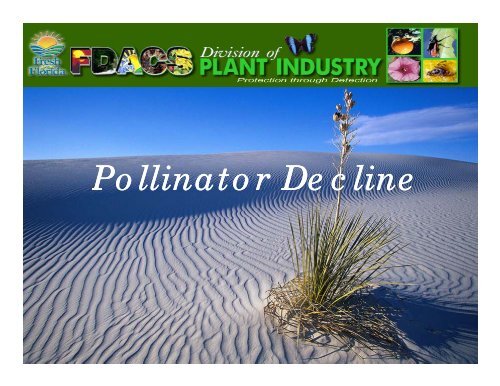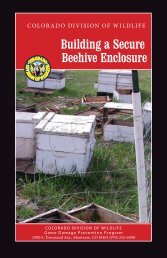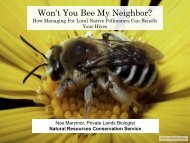Presentation by G.W. Hayes Jr - Colorado State Beekeepers ...
Presentation by G.W. Hayes Jr - Colorado State Beekeepers ...
Presentation by G.W. Hayes Jr - Colorado State Beekeepers ...
You also want an ePaper? Increase the reach of your titles
YUMPU automatically turns print PDFs into web optimized ePapers that Google loves.
Pollinator Decline
Apiary Industry<br />
Under Siege From Pests,<br />
Diseases and Now Something Called<br />
CCD
Honey Bee Colony<br />
Mortality<br />
• 2006 – 2007 32%<br />
• 2007 – 2008 36%<br />
• 2008 – 2009 29%
Agricultural Acres Planted With Pollinator Dependent<br />
Crops Has outpaced the availability of Pollinators.
Colony Losses<br />
• Globalization and Homogenization of pests,<br />
predators, parasites, diseases and honey<br />
bees<br />
• Production Agriculture<br />
• Production Bee Keeping<br />
• Pesticide id misuse<br />
• Eliminating “productive” locations to place<br />
honey bee colonies<br />
• Entomophobia<br />
• Low Honey Prices<br />
• Low Pollination Prices
The Parasitic Varroa Mite
• Think of Varroa as a dirty needle
Viruses
Nosema / Microsporidian
Small Hive Beetle
Chemicals AG
Production Beekeeping
Beekeeper Chemicals
Chemical Residue in wax<br />
100<br />
90<br />
80<br />
70<br />
60<br />
50<br />
40<br />
30<br />
20<br />
0<br />
10<br />
Coum maphos<br />
Fluva valinate<br />
Chlorpy pyrifos<br />
Coumaphos<br />
Oxon<br />
Chloroth thalonil<br />
Endosulfan n ( (total)<br />
Boscalid<br />
Dicofol<br />
Esfenva valerate<br />
Azoxyst strobin<br />
Vinclo clozolin<br />
Pesticides
Entomophobia<br />
• Loss Bee locations
Low Honey Prices
Low Pollination Prices
The CCD Factor<br />
D. vanEngelsdorp<br />
NRi N. Rice<br />
D. vanEngelsdorp<br />
N. Rice
Symptoms CCD Colonies<br />
• The normal ratio of bees and brood in a Honey Bee<br />
colony is, in a rough general sense, 2 adult Honey<br />
Bees to 1 cell of sealed brood<br />
• When the ratio reverses to 1 adult Honey Bee to 2-3<br />
cells of sealed brood…this is the latest definition of<br />
CCD<br />
D. vanEngelsdorp
Symptoms CCD Colonies<br />
• The queen is always present<br />
• Have a very low number of varroa or<br />
absence of varroa tracheal mites are<br />
found in less than 10% of samples<br />
• Nosema is found in less than 50% of<br />
samples
Pesticide Analysis<br />
• USDA Agricultural<br />
Marketing Service National<br />
Science Lab<br />
- Screening for 171 pesticides<br />
- Detection at ppb levels<br />
• Colony Matrices<br />
- Wax, bee bread and trapped pollen,<br />
adult bees, brood, royal jelly<br />
• Samples from large and small<br />
beekeeper eepe operations o of seven<br />
states<br />
M.T.Frazier
Samples Analyzed 2007-’08<br />
08<br />
• 699 samples<br />
• From<br />
• CCD study<br />
• Apple orchard study<br />
• Migratory study<br />
• Beekeeper submitted samples
Honey Bees - Excellent Indicator<br />
of Environmental Pesticides<br />
Acephate<br />
Acetamiprid<br />
Aldicarb sulfone<br />
Aldicarb sulfoxide<br />
Allethrin<br />
Amicarbazone<br />
Amitraz (2,4-DMA)<br />
Amitraz (2,4-DMPF)<br />
Atrazine<br />
Azinophos-methyl<br />
Azoxystrobin<br />
Bendiocarb<br />
Bifenthrin<br />
Boscalid<br />
Captan<br />
Carbaryl<br />
Carbaryl (1-Naphthol)<br />
Carbendazim<br />
Carbofuran, 3-hydroxy<br />
Carfentrazone<br />
Chlorfenapyr<br />
Chlorothalonil<br />
Chlorpyrifos<br />
Coumaphos<br />
Coumaphos-Chlorferone<br />
Coumaphos oxon<br />
Cyfluthrin<br />
Chlthi Cyhalothrin (ttl) (total)<br />
Cypermethrin<br />
Cyprodinil<br />
Deltamethrin<br />
Diazinon<br />
Dicofol<br />
Difenoconazole<br />
Diflubenzuron<br />
Dimethomorph<br />
Diphenylamine<br />
Endosulfan 1<br />
Endosulfan 2<br />
Endosulfan sulfate<br />
Esfenvalerate<br />
Etoxazole<br />
Fenbuconazole<br />
Fenhexamid<br />
Fenpropathrin<br />
Fluvalinate<br />
Heptachlor<br />
Hexachlorobenzene<br />
Imidacloprid<br />
Imidacloprid olefin<br />
Imidacloprid, 5-hydroxy<br />
Indoxacarb<br />
Malathion<br />
Methidathion<br />
Methoxyfenozide<br />
Methyl parathion<br />
Metolachlor<br />
Metribuzin<br />
Myclobutanil<br />
Norflurazon<br />
Oxamyl<br />
Oxyfluorfen<br />
f<br />
p,p'-DDE<br />
Pendimethalin<br />
Permethrin<br />
Phosmet<br />
Pyraclostrobin<br />
Pyrethrins<br />
Pyrimethanil<br />
Quintozene (PCNB)<br />
Sethoxydim<br />
Simazine<br />
Tebuconazole<br />
Tebufenozide<br />
Tebuthiuron<br />
Tetramethrin<br />
Thiabendazole<br />
Thiacloprid<br />
Tribufos<br />
Trifloxystrobin<br />
Trifluralin<br />
Vinclozolin
Multiresidue Pesticide Analysis on US Samples<br />
2007-0808<br />
• Up to 31 different pesticides per sample, 6+ average<br />
• Only 3 samples lacked detections<br />
• Found 73 different pesticides and 9 other metabolites<br />
-12 pyrethroids, 10 organophosphates, 5 carbamates,<br />
3 neonicotinoids<br />
- 3 insect growth regulators, 2 organochlorines, 2 chlorinated cyclodienes,<br />
- 20 fungicides, 12 herbicides, 2 acaricides, 1 synergist, 1 misc.<br />
• At least 14 of these are systemic pesticides
What impact are they<br />
having?<br />
• Toxic effect (multiple pesticides) (Sara Ashcraft)<br />
• Synergistic insecticides + fungicides<br />
• Behavioral effects<br />
• Learning and retention (Daniel Schmehl)<br />
• Comparison of European and African bees<br />
• Physiological i l effects<br />
• Immune system function (Diana Cox-Foster)<br />
• Longevity
Outcomes of Beehive Pesticide Analysis<br />
• No commodity has had as many detections at such high amounts in so few<br />
samples over such a short time as has bee pollen<br />
• Highest detections were in-house varroacides, fluvalinate and coumaphos, but<br />
about 80 other pesticides and metabolites found<br />
•Pyrethroids known to impact foraging behavior dominate<br />
• No individual chemical is likely to explain CCD<br />
• Impacts of multiple pesticide residues in bee food most likely will be via<br />
synergistic interactions at sublethal levels on key behaviors/physiology<br />
• Systemic or other fungicides occur at levels that may synergize with<br />
pyrethroids, organophosphates or neonicotinoids.<br />
• Role of pesticides and diseases like IAPV in CCD remains to be reconstituted in<br />
lab bioassays at relevant doses
Why Neonicotinoids and<br />
Fungicides?<br />
id • Environmental contaminants are a research priority<br />
• Neonicotionoids - a relatively new class of<br />
pesticides (imadicloprid introduced in 1991)<br />
• now the most widely used class of pesticides in US<br />
• Most are known to be highly toxic to bees<br />
• EPA fact sheet, numerous studies, product labels<br />
• Neonicotinoids and some fungicides are synergistic<br />
= more toxic<br />
Funding:<br />
Florida <strong>State</strong> and Tampa Bay <strong>Beekeepers</strong> Associations<br />
National Honey Board, Other <strong>State</strong> and local associations
Difficulty of Assessing<br />
Impact<br />
• Geographical wide-spread (world-wide) wide)<br />
• Soil types<br />
• Wide variety of crops, ornamental, forest, turf and structural<br />
situations<br />
• Varied application techniques<br />
• seed treatment, foliar spray, granular soil application and liquid<br />
drench<br />
• Increasing rate at which they are being used<br />
• Now the most widely used class of pesticides in the US<br />
• Complex behavior and activities of honey bees
Evidence of<br />
Fungal<br />
Conditions<br />
D. vanEngelsdorp
Pathogen<br />
D. vanEngelsdorp
Amoeba<br />
Disease<br />
D. vanEngelsdorp
Nodules<br />
• Iridescent Virus?
Area of Focus<br />
Honey Bee Health Challenges<br />
Primary Stress<br />
Varroa Mites<br />
Management<br />
Nutrition<br />
Pesticides<br />
Secondary Pathogens<br />
Nosema<br />
Fungi
Ecosystems Stability<br />
- Complex relationships<br />
- Interconnected elements<br />
species, water, soil<br />
- All groups/guilds are important<br />
and play critical roles<br />
- Balanced equilibrium<br />
ALSO<br />
- Dynamic; can change, respond<br />
to and often recover from<br />
negative inputs or damage
QuickTime and a<br />
decompressor<br />
are needed to see this picture.<br />
The herbicide atrazine is linked<br />
to reproductive problems in frogs<br />
EPA commissioned study - no<br />
connection found<br />
2008 Study<br />
Jason Rohr Univ. of S. Florida<br />
and others<br />
1980’s worldwide decline<br />
in frog populations<br />
Disease and habitat<br />
destruction are blamed<br />
Atrazine kills off floating mats of<br />
algae, allowing algae on the<br />
pond bottom to thrive<br />
Snails flourish;flatworm host<br />
Flatworms parasitize frogs!
Ecosystems Instability<br />
The balance can be “tipped” resulting in a cascade of<br />
negative ecological consequences = serious damage.<br />
Pesticides associated with tipping the balance.
Honey Bee Colony “Ecosystems”<br />
- Complex relationships<br />
- Interconnected elements<br />
- queens, workers, comb, food resources<br />
- Groups/castes play critical roles<br />
- Balanced equilibrium<br />
ALSO<br />
-worker/brood ratios<br />
-nurse/house/forager bee ratios<br />
S. Camazine<br />
- Dynamic; can change, respond to<br />
and often recover from negative inputs<br />
- lost field force = precocious foragers
BUT the balance can be “tipped” resulting in a cascade<br />
of negative consequences = serious damage<br />
population declines? CCD?
Why is CCD<br />
Important?
But Does Any of This<br />
Matter?<br />
• “You, Me and all of your Neighbors know<br />
food comes from the grocery store.”
USDA Projections<br />
• 40% of our Veggies will Come from Non-<br />
US sources <strong>by</strong> 2012<br />
• US will be a Net Food Importer in 50<br />
years
Thank You from Sunny<br />
Florida





